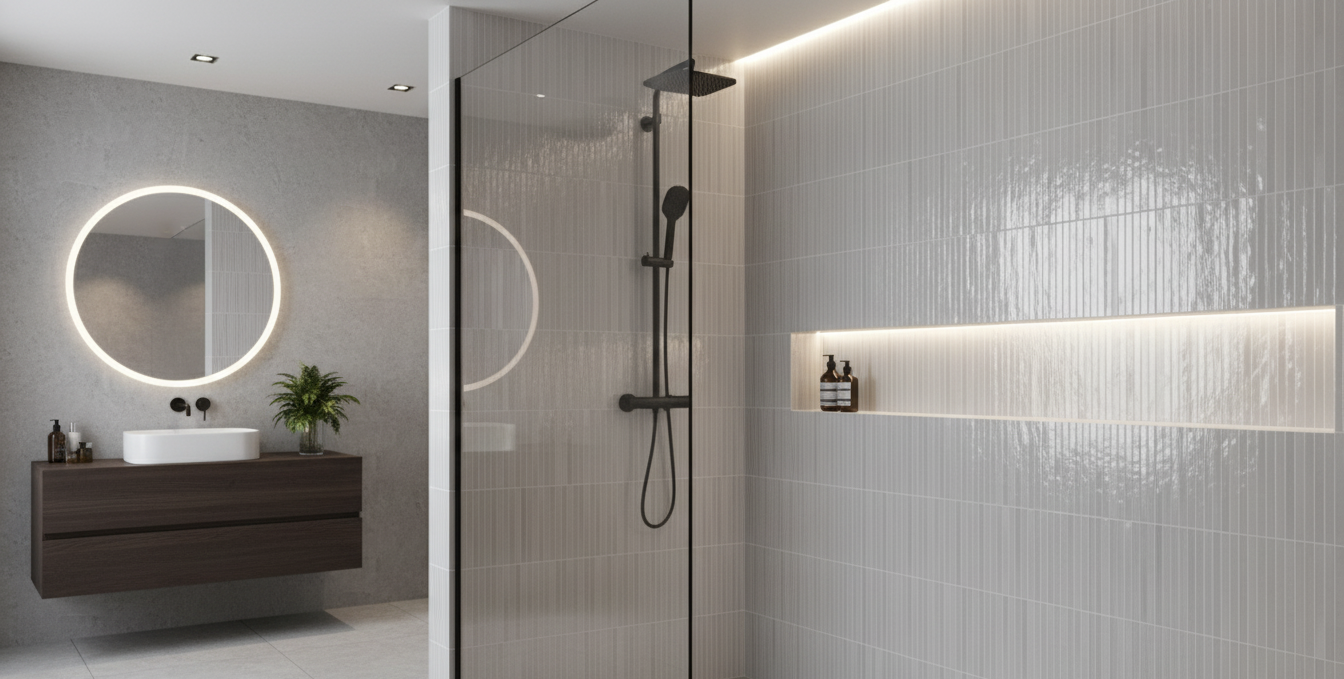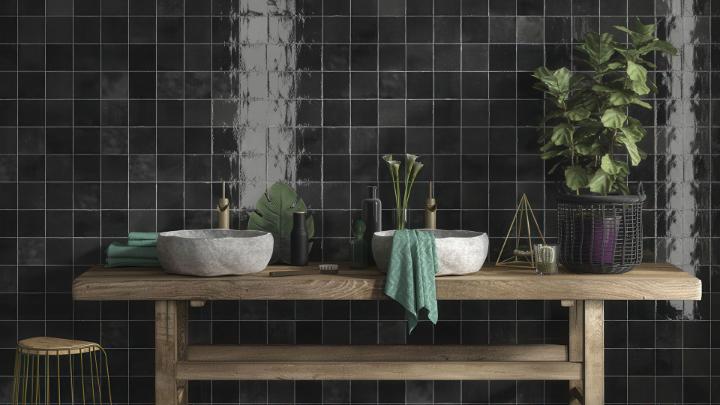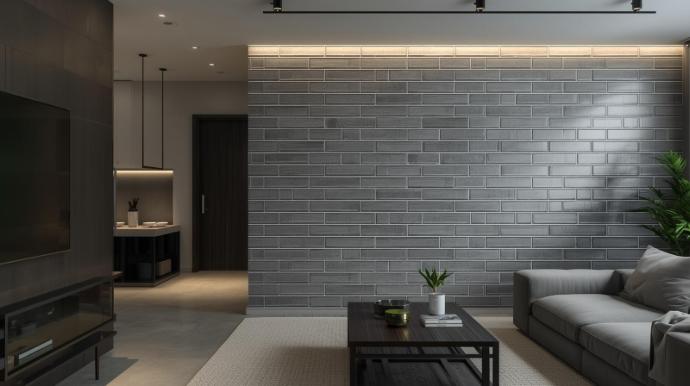Horizontal subway tiles make rooms appear wider and are easier to maintain, while vertical subway tiles create height illusion and offer a modern aesthetic. Your choice depends on room dimensions, design goals, and maintenance preferences.
Key Differences Between Vertical vs Horizontal Subway Tiles:
- Horizontal orientation: Creates width perception, easier cleaning, classic timeless look
- Vertical orientation: Generates height illusion, modern minimalist appeal, emphasizes specific features
- Best for small spaces: Horizontal for narrow rooms, vertical for low-ceiling areas
- Maintenance: Horizontal has fewer grout lines (easier to clean), vertical has more grout lines
- Cost difference: Materials cost the same, minimal labor cost variation
- Current trends: Both orientations popular, with vertical gaining momentum in contemporary designs
Subway tiles remain the most versatile choice for kitchen backsplashes, bathroom walls, and shower installations in 2025. This comprehensive guide examines visual effects, practical considerations, maintenance requirements, and design trends to help homeowners make informed decisions about tile orientation. Whether renovating a compact bathroom, updating a kitchen backsplash, or designing a new shower, understanding how tile direction affects space perception and functionality ensures optimal results for your specific project needs.
Understanding How Tile Direction Affects Room Perception

Vertical Installation Creates Height Illusion
Installing subway tiles in vertical alignment produces dramatic upward visual movement. These ascending lines mirror architectural principles found in towering structures and cathedral designs, generating an impression of elevated ceilings and expanded vertical space. This technique proves especially valuable in rooms with standard ceiling heights that benefit from perceived added dimension.
Horizontal Layout Expands Width Perception
Horizontally positioned subway tiles generate lateral visual flow across wall surfaces. This sideways movement creates breadth perception, making narrow spaces appear wider and more welcoming. Compact kitchens and small bathrooms particularly benefit from this optical expansion technique, as horizontal lines combat cramped feelings.
Debunking Space Expansion Myths
Many homeowners mistakenly believe horizontal subway tile installation physically enlarges room dimensions. While these ceramic tile options cannot modify actual square footage, they successfully create spatial illusions that enhance room comfort and visual appeal. The psychological impact of perceived space expansion significantly improves overall room atmosphere.
Grout Line Impact on Design Aesthetics
Grout placement between tiles substantially influences final appearance. Horizontal subway arrangements typically feature extended grout lines that may appear more prominent or busy. Minimize this effect by selecting smaller tile formats or grout colors that closely match your tile selection for seamless integration.
Tile Size Considerations for Spatial Impact
Subway tile dimensions directly affect room perception. Oversized tiles deliver bold contemporary statements but may compress spatial feelings. Smaller formats provide refined elegance while maintaining open, airy sensations. Match your tile size selection to your room's specific proportions and layout requirements.
Consider your space's unique characteristics when making orientation decisions. Narrow corridors benefit from vertical arrangements that add height perception, while compact kitchens often work better with horizontal layouts that create width illusion.
Current Design Movement Analysis

Traditional Horizontal Approach
Horizontal subway tile stacking maintains its position as a kitchen and bathroom standard, channeling classic New York subway station aesthetics. This enduring arrangement, typically featuring white or neutral tones with matching grout, creates clean, adaptable foundations for any design scheme. Modern interpretations now incorporate vibrant colors, contrasting grout selections, and innovative patterns for contemporary personalization.
Contemporary Vertical Trend
Vertical subway tile installation has gained significant momentum in recent design circles, offering streamlined minimalist appeal. These upward arrangements generate spaciousness and openness, making them perfect solutions for smaller kitchen and bathroom renovation projects. Vertical layouts produce striking visual drama, particularly when combined with bold color choices or statement grout selections. Premium tiles paired with dark grout create sophisticated modern backsplash drama, while bright contrasting grout generates playful, energetic environments.
Creative Pattern Alternatives Beyond Basic Layouts
Standard vertical and horizontal orientations represent just the beginning of subway tile possibilities. Alternative arrangements including herringbone, basketweave, and chevron patterns introduce texture, dimension, and dynamic movement to your design scheme.
Herringbone patterns utilize diagonal tile placement for versatility in both horizontal and vertical applications, creating compelling visual interest. Basketweave designs feature interlocking square formations that add textural complexity, while chevron arrangements use distinctive V-shaped configurations for bold, sophisticated focal points. These creative alternatives provide opportunities for unique subway tile experimentation tailored to your specific space requirements.

Professional Installation Strategies
Strategic Planning Phase
Develop comprehensive layout plans or sketches before beginning installation. Whether pursuing classic brick patterns or adventurous arrangements like herringbone or basketweave, visualization ensures proper material preparation and tool readiness. Advanced planning prevents installation surprises and streamlines the entire process.
Essential Tool Assembly
Collect necessary installation equipment including levels, tile cutters, adhesives, and grout materials. Quality tools facilitate smoother processes and ensure precise cutting and alignment results. For detailed guidance, refer to professional tile installation guides that walk through each step of the process.
Skill Development Through Practice
Newcomers to tiling should practice techniques on small test sections before attempting larger projects. This preparation builds comfort with tools and methods, improving confidence for main installation phases.
Precision Installation Focus
Follow manufacturer guidelines carefully for both tile placement and grout application. Maintain consistent tile spacing, ensure straight grout lines, and apply grout sealer afterward for stain and moisture protection. Professional backsplash tiling techniques can provide additional insights for achieving flawless results.
Professional Consultation Benefits
When uncertain about tiling abilities or facing installation challenges, consult qualified professionals. Expert tile installers deliver beautiful, long-lasting subway tile results. Nova Tile and Stone offers professional installation recommendations and project guidance for homeowners throughout their renovation journey.
Functional Considerations Beyond Appearance
Grout Performance and Maintenance
Subway tile orientation significantly impacts practical functionality. Horizontal layouts typically feature fewer, longer grout lines for easier cleaning and maintenance. Vertical arrangements create more, shorter grout lines that may require additional cleaning effort. Mitigate grout line maintenance challenges by selecting colors that blend seamlessly with tiles or using sealed grout products that resist stains and moisture.
Visual Flow Coordination
Tile orientation affects spatial visual continuity. Horizontal subway tiles create cohesion and flow, especially when aligned with countertops, appliances, or architectural features. This alignment generates unified, visually appealing spaces. Vertical orientations effectively emphasize specific areas or features like backsplashes or shower walls.
Surface Finish Influence
Subway tile materials impact orientation selection. Glossy tiles often work best in horizontal layouts to maximize reflective shimmer effects. While vertical glossy arrangements remain attractive, they may not deliver identical visual impact. Textured tiles featuring raised or embossed patterns work in either orientation, though vertical layouts may better highlight texture and dimensional depth. Understanding ceramic tile properties helps in making informed decisions about surface finishes.
Additional Practical Factors
Consider household-specific needs when choosing orientation. Families with young children or pets might prefer darker grout colors that hide stains better. High-humidity installations in bathroom environments require sealed, moisture-resistant grout products regardless of orientation choice.
Making Your Final Orientation Decision
This guide has examined multiple factors influencing horizontal versus vertical subway tile selection, from spatial perception impacts to maintenance practicalities and design trends. Both orientations offer distinct advantages, with optimal choices depending on personal style preferences and specific space characteristics.
Embrace your individual design aesthetic when selecting subway tile orientation. Both horizontal and vertical layouts can complement your overall design vision when properly executed. Consider how orientation integrates with your color palette, tile finish selection, and desired room ambiance. Factor in your space's dimensions, configuration, and layout specifics. Small, narrow rooms often benefit from horizontal tiles that create width perception, while tall, open spaces may be enhanced through vertical arrangements. Natural lighting and air circulation also influence tile appearance, so evaluate these environmental elements in your decision process.
Experiment with different orientation options before finalizing your choice. Create design mockups using online tools or arrange sample tiles in your actual space for better visualization. Testing different layouts enables informed decision-making, ensuring your final design aligns with your space transformation goals. Through creative planning and careful consideration, you'll achieve a subway tile installation that perfectly transforms your environment.
Browse our comprehensive selection of tiles by type to discover subway tile options that match your preferred orientation and design aesthetic. Our curated collection includes various styles and patterns that ensure you'll find the perfect tiles for your specific project requirements.
Conclusion
Choosing between vertical and horizontal subway tile orientation doesn't have to be overwhelming when you understand the key principles at play. Both directions offer unique advantages that can dramatically transform your space when applied thoughtfully. Vertical installations excel at creating height illusions and modern sophistication, making them ideal for compact spaces needing visual elevation. Horizontal arrangements provide timeless appeal while generating width perception and easier maintenance routines.
The most successful subway tile projects consider multiple factors simultaneously: room dimensions, lighting conditions, maintenance requirements, design style preferences, and household lifestyle needs. Remember that no single orientation works universally, your specific space characteristics should guide your decision-making process.
Take time to visualize both options in your actual environment before committing to installation. Whether you choose the classic horizontal approach or embrace contemporary vertical trends, proper planning and quality execution will deliver stunning results that enhance your home's value and daily enjoyment for years to come. For inspiration and the latest in current kitchen design trends, consider how your tile choice fits within broader design movements.
Visit our showroom locally to see subway tile orientations in person and get hands-on assistance from our tile experts. This allows you to experience how different orientations look under various lighting conditions before making your final decision.
Frequently Asked Questions
Which subway tile orientation makes small bathrooms look bigger?
Horizontal subway tile installation typically makes small bathrooms appear larger by creating width perception through lateral visual flow. The sideways movement of horizontal lines tricks the eye into perceiving expanded breadth, which is particularly beneficial in narrow bathroom layouts. However, if your bathroom has low ceilings, vertical installation might be more effective as it creates height illusion that opens up the vertical space. When planning a renovation, consider overall bathroom renovation costs to budget appropriately for your project.
Is vertical or horizontal subway tile easier to clean and maintain?
Horizontal subway tile layouts are generally easier to clean and maintain because they feature fewer, longer grout lines compared to vertical installations. Vertical arrangements create more numerous, shorter grout lines that require additional cleaning attention. However, you can minimize maintenance challenges in either orientation by choosing grout colors that closely match your tiles or using high-quality sealed grout products that resist stains and moisture.
Do vertical subway tiles cost more to install than horizontal ones?
The material costs for subway tiles remain the same regardless of orientation, but installation labor costs may vary slightly. Vertical installations sometimes require more precise cutting and additional planning, potentially increasing labor time. However, the cost difference is typically minimal when working with experienced tile installers. The bigger cost factors include tile quality, size, grout selection, and surface preparation requirements rather than orientation choice. Explore our complete product selection to compare pricing across different tile options and find solutions that fit your budget.
Can I mix vertical and horizontal subway tiles in the same room?
Yes, combining vertical and horizontal subway tile orientations in the same space can create stunning design contrast and visual interest. This approach works particularly well when defining different functional areas, for example, using horizontal tiles for the main backsplash and vertical tiles for accent areas or alcoves. Ensure consistent tile size, color, and finish across both orientations for cohesive results, and consider using transition strips or borders where orientations meet. For complex installations, professional bathroom tile replacement techniques may be necessary.
What grout color works best with vertical subway tiles?
Grout color selection for vertical subway tiles depends on your desired aesthetic outcome. Light grout colors that closely match your tile create seamless, continuous appearances that emphasize the clean lines of vertical installation. Contrasting dark grout colors highlight individual tiles and create dramatic grid patterns that add visual texture. For maintenance ease, medium-toned grout colors hide stains better than pure white options while still providing attractive contrast against most subway tile colors.
For expert guidance on selecting the perfect subway tile orientation and style for your specific project needs, contact our team of tile specialists. We provide personalized recommendations based on your space requirements, design preferences, and budget considerations. Learn more about our company and our commitment to helping homeowners achieve their tile renovation goals with quality products we carry from trusted manufacturers.
Additional creative inspiration can be found through design inspiration from leading experts who showcase innovative approaches to subway tile installation. Whether you're planning a complete renovation or simple updates, the right subway tile orientation can transform your space beautifully.